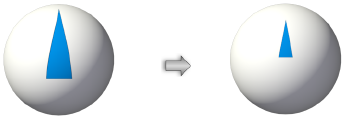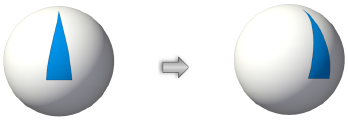Create or import a texture resource as described in Creating Textures.
Select the object or objects to texture. If more than one object is selected, the texture resource applies to all objects in the selection. Additional mapping parameters are available for multiple selected objects so the texture renders seamlessly.
Curtain wall textures are determined by frame and panel settings, and cannot be set from the Render tab.
On the Attributes palette, select any Fill Style other than None (otherwise the texture will not render).
Click the Render tab from the Object Info palette and specify the rendering settings.
► Click to show/hide the parameters.
Parameter |
Description |
Mode |
For objects with textureable components, such as walls, roofs, and slabs, select whether to apply the texture By Object or By Component. For the best drawing accuracy, setting wall, roof, and slab textures By Component is recommended. |
Part |
Some objects can have different textures (including decals) applied to different parts. ● For extrudes, sweeps, slabs, floors, and roof faces, apply textures to the top, bottom, and sides. ● For slabs (Vectorworks Design Series required), the Mode selection determines whether to apply textures from the slab components or from the slab. If you select By Component mode, the textures set for the slab components also determine the slab textures (see Creating Slab Components). If you select By Object mode, apply textures to the top, bottom, and sides. ● For standard walls and round walls, the Mode selection determines whether to apply textures from the wall components or from the wall. If you select By Component mode, the textures set for the wall components also determine the wall textures (see Creating Wall Components). If you select By Object mode, apply textures to the left, right, top, bottom, start cap, end cap, and holes. Left and right wall texture parts can only be applied to wall holes when editing the wall hole component; see Adding a 3D Wall Hole Component to a Symbol Definition. ► Click here for a video tip about this topic (internet access required). Curtain wall textures are determined by frame and panel settings, and cannot be set from the Render tab. ● For roof objects, apply textures to the top, bottom, sides, and dormer walls, and if Vectorworks Design Series products are installed, fascia, attic, and soffit. The Part option is not available for objects without distinct parts. ● For mesh objects imported from SketchUp or 3ds (Vectorworks Design Series required), the imported model determines the number of texture parts for the mesh object. A numerical list indicates how many unique textures are assigned to the imported mesh faces; the individual parts are not named. The texture or decal applied to each part displays in parentheses next to the part. To apply a texture to Overall or to a part, select it and then select a texture to apply from the texture list. Overall indicates that the same texture applies to all parts of the object. Parts that have been assigned a texture different from Overall display above the divider, and parts with the same texture as Overall display below the divider.
Overall no longer displays when all parts use distinct textures. The additional parts do not display when setting class textures (see Concept: Applying Textures by Class to Objects and Components). A wall’s start cap, if set to obtain its texture by class, uses the class texture assigned to the wall center. |
Revert to Overall |
If a part is assigned a texture but it should inherit its texture from Overall instead, select the part and click Revert to Overall. The part moves back below the divider, and (from Overall) displays as its texture name. Any decals applied to the part are removed. |
Add Decal |
Adds a decal texture to the selected part; see Creating Decal Textures |
Texture list |
Select the texture to apply from a library or the current file |
Texture menu |
Click the arrow next to the texture list to open the Texture menu. The texture resource or shader used to create the resource can be edited from here as described in Editing Textures and Shaders of Selected Objects. An associated surface hatch can also be edited. Before editing, the resource can be copied to preserve the original resource parameters. |
Thumbnail view |
Displays a thumbnail view of the selected texture |
Map Type |
Select how the texture is applied to the 3D object; see Map Types |
Reset to Default Mapping |
Removes any changes made by the Attribute Mapping tool or in the Object Info palette, restoring the texture to its original location, scale, and rotation |
Scale |
Determines the texture size when projected onto the object. For example, a value of 2 doubles the size of the texture projection. Either enter a scale value or use the slider to change the scale.
|
Offset H |
Sets the start location of the texture horizontally
|
Offset V |
Sets the start location of the texture vertically
|
Rotation |
Sets the angle of texture rotation. Either enter a rotation value from 0 to 360 degrees or use the slider to change the rotation angle.
|
Repeat Horizontally |
Repeats the texture in a horizontal direction |
Repeat Vertically |
Repeats the texture in a vertical direction |
Flip Horizontally |
Flips the texture horizontally, along the vertical axis |
Flip Vertically |
Flips the texture vertically, along the horizontal axis |
Radius |
For sphere and cylinder map types, sets the texture radius; the default radius is the same as the 3D object radius. Increasing this value reduces the size of the texture on the object. |
Follow Longest Edge |
Aligns the texture’s U axis with the long edge of a face, for simpler mapping when the auto-align plane map type is selected. When deselected, the texture aligns horizontally in object space. |
Use World Z For Origin |
Sets the texture’s Z origin to be relative to the world Z origin, rather than to object space. This allows seamless texture application across multiple layers for all mapping types. Multiple objects with this parameter enabled render seamlessly along the Z axis. |
Align Selected Mappings |
For plane, cylinder, and sphere map types, aligns the texture mapping of multiple selected objects, giving them the appearance of a shared texture. Multiple objects with this parameter enabled use the mapping parameters of the first selected object, and the texture appears seamless across all selected objects. The shared mapping depends on the objects currently selected and can change with a different selection of objects. This parameter is not available for auto-align plane, perimeter, or roof map types. |
Mesh Smoothing |
Set the mesh smoothing preference for the selected object(s) to None, Use Document Preference, Custom Crease Angle, or Imported. If Custom Crease Angle is selected, specify the desired Crease Angle. Mesh objects imported from SketchUp or 3ds are automatically set to Imported to preserve the surface normal data from the original imported file. Imported smooth normals can be disabled and edited by selecting a different mesh smoothing option, but imported smooth normal data is deleted if the mesh is edited. This setting overrides the document preference mesh smoothing setting for the selected object(s) only. To set the document preference for mesh smoothing, see Document Preferences: Display Tab. This parameter is available for editing OpenGL renderings in Vectorworks Design Series products. |
Update |
Updates the drawing display |
You can also apply a texture from the Resource Manager. Select the object, and then right-click on the resource, and select Apply from the context menu. Alternatively, double-click the resource, or drag the resource onto the object to apply it. To edit the mapping, use the Object Info palette or the Attribute Mapping tool.
The texture is applied to the selected object(s).




